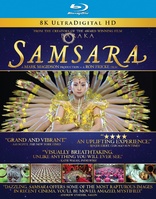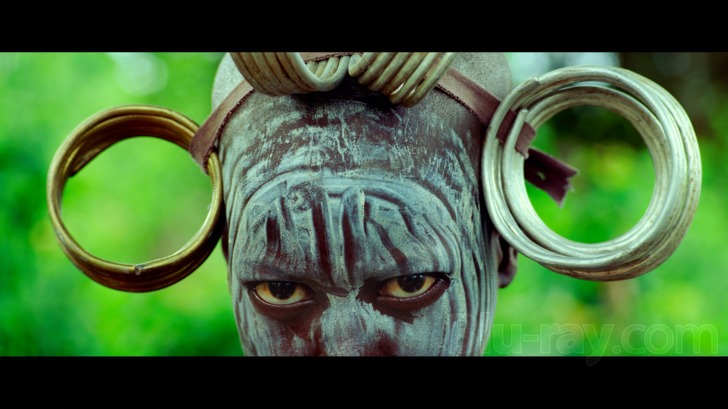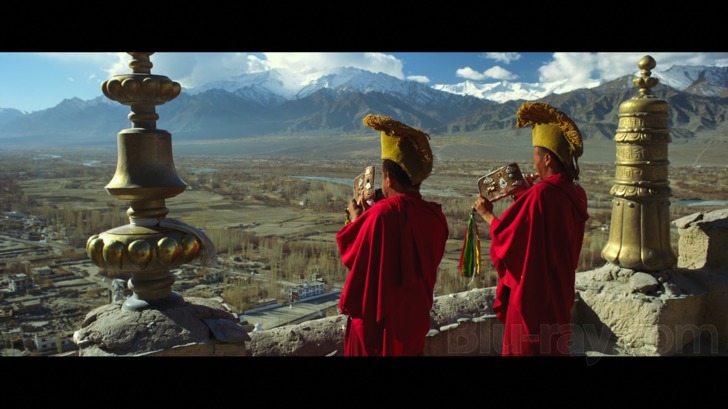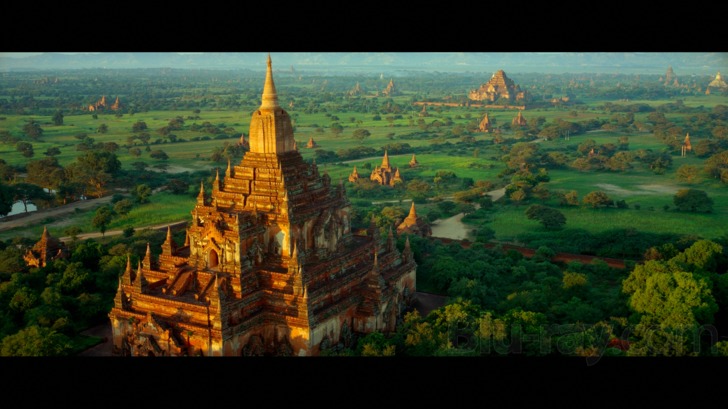Samsara Blu-ray Movie
HomeSamsara Blu-ray Movie 
MPI Media Group | 2011 | 102 min | Rated PG-13 | Jan 08, 2013
Price
List price:Third party: $28.67 (Save 18%)
Listed on Amazon marketplace
Buy it from YesAsia:
Movie rating
8.3 | / 10 |
Blu-ray rating
| Users | 5.0 | |
| Reviewer | 5.0 | |
| Overall | 5.0 |
Overview
Samsara (2011)
Filmed over a period of five years in twenty-five countries on five continents, and shot on 70mm film, Samsara transports us to the varied worlds of sacred grounds, disaster zones, industrial complexes, and natural wonders.
Director: Ron Fricke| Documentary | Uncertain |
| Nature | Uncertain |
Specifications
Video
Video codec: MPEG-4 AVC
Video resolution: 1080p
Aspect ratio: 2.39:1
Original aspect ratio: 2.39:1
Audio
Music: DTS-HD Master Audio 7.1 (96kHz, 24-bit)
Music: Dolby Digital 5.1
Subtitles
None
Discs
50GB Blu-ray Disc
Single disc (1 BD)
Playback
Region A (locked)
Review
Rating summary
| Movie | 4.5 | |
| Video | 5.0 | |
| Audio | 5.0 | |
| Extras | 4.0 | |
| Overall | 5.0 |
Samsara Blu-ray Movie Review
All Things Shining
Reviewed by Casey Broadwater January 4, 2013When the two Voyager spacecraft launched in 1977, each carried a golden record etched with an eclectic collection of world
music, greetings in several languages, sounds from earth, and 115 photographs documenting life on our pale blue dot. The
hope—and this is a long shot in more ways than one—is that eons from now they might be discovered by an extraterrestrial
civilization significantly advanced to decipher the records' contents. We can imagine the aliens puzzling over the depictions of
these strange earthlings, with their Chuck Berry and Johann Sebastian Bach songs, their unusual anatomy, their
supermarkets and highways and rocket launches. What would they make of us?
I like to think that the non-narrative, experimental documentary films of director Ron Fricke and his longtime producer Mark
Magidson may eventually serve a similar function, if not for aliens then for distant human historians making visual sense of
the state of Earth circa the end of the 20th century and the beginning of the 21st. The two first worked together on 1985's
Chronos, an IMAX movie that—as the title implies—examines the passage of time, on scales both large and small,
using innovative time-lapse photography. They followed this with 1992's magnificent Baraka, which Fricke describes
as "a guided meditation on humanity," shot in 25 countries on gorgeous 70mm film. And now, using the techniques they've
honed after a career of working together, they've delivered the 5-years-in-the-making Samsara, their most epic and
affecting production yet. Part National Geographic-style travelogue, part buddhistic reflection on the cycle of life, death, and
rebirth, the film is a rare pure-cinema experience that engages both your lizard brain and the higher states of your consciousness. That
is, you'll spend most of Samsara in a kind of primal awe at the sheer splendor of the imagery, while another part of
you is busy pulling together symbolic associations and ruminating on the nature of mankind. What should we make of
us?

The title is a Sanskrit word that refers to the endless wheel of life. It literally means "continuous flow," and that's a good way to describe Samsara, which snakes from one location to the next, cutting between similar or disparate scenes to evoke unspoken associations. Fricke and Magidson's editing style often conforms to Sergei Eisenstein's theory of montage; in a completely wordless film, they're able to express complex ideas simply through hard cuts—one image placed immediately next to another inevitably creates a third mental picture in the viewer's mind.
The most jarring example is probably a long sequence that dispassionately shows a series of meat and dairy processing facilities. Chickens are scooped up onto a conveyor belt. Cows on an enormous rotating platform are machine-milked. Pig carcasses hang from hooks, looking disconcertingly like human bodies. From here, the film cuts to the sprawling warehouse interior of a Costco, where shoppers are buying bulk toilet paper and ground meat. The effect is intentional disgust, and there's a reasonable argument to be made that Samsara paints a bleaker portrait of humanity than its predecessor. But I don't think Fricke and Madgidson are out to make a point about vegetarianism or spread some anti-consumerist message; they're just saying, this is the world, as it is. Some of their allusions may be a bit too obvious or pointed— like showing a badly scarred soldier immediately after a tour of a munitions plant—but the filmmakers generally resist spin or politics. We're left to draw our own conclusions.
Where Baraka has an effused spiritual glow—all wonder and amazement—Samsara feels more earthly, more entwined with human flourishing and suffering. The film is constantly playing with contrast in order to show the scope and variety of human existence. One cut takes us from the piercing stare of a Namibian tribeswoman to a soaring pass over the Los Angeles freeway system and its adjoining suburban sprawl. An in-utero image of a developing fetus jumps to a shot of a long-dead, mummified old man. Out of an ancient desert, the ultra-modern Burj Khalifa tower—the tallest building in the world—stands defiantly, improbably, bizarrely.
There's no lack of bizarre here. In the middle of the film, we stare deep into the uncanny valley as we come face to face with robotics professor Hiroshi Ishiguro and his robot doppelgänger, which looks incredibly real but moves in uneasy, not-quite- human twitches. In the most unsettling sequence, a performance artist in a suit and tie sits at a desk—we initially assume he's a businessman—and suddenly smears his face with clay, daubs it with red and black ink, and transforms himself into some witchy, animalistic representation of the id. It's terrifying and unexpected, and it takes Samsara in a darker direction than Fricke and Magidson have gone before.
There are numerous other strange sights to behold as the film touches on love and death, violence and sexuality, family and technology. Preserved in her glass coffin, we see the embalmed body of two-year-old Rosalia Lombardo—the "Sleeping Beauty of the Capuchin Catacombs"—while somewhere in Africa, a warlord is buried in a pinewood AK-47. Inside a Japanese sex doll factory, half-completed silicon specimens lay splayed out for inspection. A man covered head-to-toe in tattoos cradles and coos at his infant child. Filipino prisoners—you might've seen them on YouTube—dance in startling unison. Workers at a recycling facility pick through computer parts, surrounded by stacked-up mountains of disused motherboards. This world—our world—is overwhelmingly weird.
Of course, Samsara isn't all oddity. As you'd expect from the creators of Baraka—Fricke also served as director of photography for Godfrey Reggio's Koyaanisqatsi, which kick-started this whole non-verbal documentary genre—there are also many scenes of stunning natural and manmade beauty, from volcanic eruptions and glacial peaks to burnished temples rising out of the jungle and gleaming in the morning light. Perhaps the single most arresting image—and really, it's hard to pick just one—is the sped-up footage of millions of pilgrims at Mecca, dressed in white, circling around the Kaaba, the black cuboid building that all Muslims around the world face during prayer.
Samsara is about all things—shining and horrible, destructive and creative—but the overwhelming impression is of impermanence. The ruins of a post-Katrina elementary school. Tokyo's busy Shibuya Station crossing, where thousands of busy lives intersect at every change of the traffic lights. Stone busts slowly eroding Ozymandeus-like in the desert. Thematically bookending the film, a group of Tibetan monks carefully construct a mandala out of multi-colored sand and—when they finish—immediately wipe away the intricate design, smearing it into oblivion. We're here for the briefest flash of time, and then we're gone. We might as well take in as much of the world as we can, while we can, and Samsara makes that daunting task a little easier.
Samsara Blu-ray Movie, Video Quality 

This is your new high definition demo disc. It's as simple as that. Shot in 70mm, scanned at 8K, and mastered at 4K, Samsara outdoes even Baraka—it's spiritual and technological predecessor—with a 1080p/AVC-encoded Blu- ray presentation that's start-to-finish gorgeous. The screenshots really do speak for themselves; for clarity and color and sheer jaw-drop factor, this transfer is unparalleled, even among other 70mm productions. The large-format cinematography here has such dimensionality and presence that the image nearly passes for 3D. Stone busts seem to loom out of the frame, and the water-sculpted walls of a canyon recede with near-tangible depth, to give but two of many possible examples. Each and every frame is strikingly defined, revealing the finest textures of rock walls, human faces, and intricate clothing. In the mandala sequence, individual grains of sand can be made out, even in longer shots. Color is just as striking—dense, vivid, and anchored by deep blacks and perfect contrast. Besides two or three instances of extremely slight aliasing/moire on fine patterns—where the sharpness of the 70mm picture is effectively outresolving 1080p—there's nothing here whatsoever to mar the picture. Grain is extremely fine, there's no banding or errant compression artifacts, no digital noise reduction or unnecessary edge enhancement. Samsara looks pure, and as far as I'm concerned, it's now the film to beat when it comes to picture quality.
Samsara Blu-ray Movie, Audio Quality 

One aspect of the film I neglected to mention in my review above is the emotive and propulsive score by multi-instrumentalist Michael Stearns, singer/composer Lisa Gerrard—who had both previously worked on Baraka—and Marcello De Francisci. The music borrows from numerous world traditions without being able to be pinned down, and it suits the film wonderfully. It also sounds great, premiering on Blu-ray with a lossless DTS-HD Master Audio 7.1 surround track that reproduces the breathy flutes, ambient droning, and choral expressiveness with ease. While there are no words—no narration, no interviews, no conversation—this is definitely not a silent film. The mix is constantly alive with both the music and washes of natural—or manmade—sound, filling all channels with excellent directionality and immersion. Wind whipping off the tops of sand dunes. The deep LFE-assisted rumble of a volcanic eruption. The tiniest servo noises of professor Ishiguro's robot. The sounds of typing emerging from a sea of cubicles. Soldiers marching in rigid unison. Everything has tremendous clarity and presence, and I'd recommend listening to the film loud to get the full effect.
Samsara Blu-ray Movie, Special Features and Extras 

- Behind the Scenes (HD, 49:02): There's only one real supplementary feature on the disc, but it's a great one—a substantial six-part making-of documentary that takes us through the initial concept, the globe-hopping production, the editing process, the creation of the musical score, the technical aspects of shooting in 70mm, and the filmmakers' own thoughts about Samsara.
- Internet Teaser (HD, 1:03)
- Theatrical Trailer (HD, 1:36)
Samsara Blu-ray Movie, Overall Score and Recommendation 

Samsara is gorgeous and thought-provoking, even more so than Baraka, Ron Fricke and Mark Magidson's previous non-verbal documentary film. I went in expecting more of the same—a contemplative experience with trance-inducing imagery of the natural and manmade world—and I definitely got that, but I also got a more meaningful, even-handed look at humanity, its triumphs and failures, its depth and variations and universality. On top of that, Samsara might just be the most jaw-dropping high definition experience yet, unrivaled in clarity and color. (I'm withholding final judgement until I see the Blu-ray of Paul Thomas Anderson's The Master, which was also shot on 70mm.) I know we're early in the year, but I'm fairly confident Samsara will go down as one of the best Blu-ray releases of 2013. Highly recommended!
Similar titles
Similar titles you might also like

Baraka
1992

Chronos
IMAX
1985

HOME
2009

Human Planet: The Complete Series
BBC
2011

Planet Earth
The Complete Series
2006

Naqoyqatsi
2002

Powaqqatsi
1988

Earth: One Amazing Day 4K
2017

Planet Earth II 4K
2016

Koyaanisqatsi
Theatrical and Demo Versions
1982

Rivers & Tides
2001

Frozen Planet
The Original UK Series
2011

Discovery Atlas: Complete Collection

Life
BBC / Narrated by David Attenborough
2009

Africa
2013

Encounters at the End of the World
2007

The Ultimate Wave: Tahiti 3D
IMAX
2010

Wild China
2008

Ganges
2007

The Salt of the Earth
Le Sel de la Terre
2014